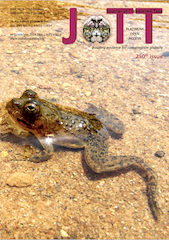Effect of socio-ecological factors and parasite infection on body condition of Brown Mouse Lemur Microcebus rufus (Mammalia: Primates: Cheirogaleidae)
Main Article Content
Abstract
Various studies in ecology have shown the relationship between body condition and parasitic loads in nonhuman primates, however, little information is available regarding prosimians such as lemurs. In this study, the synergistic effect of parasite infection and socio-ecological factors on the body condition of Microcebus rufus in the family Cheirogaleidae was analyzed in Ranomafana National Park in southeastern Madagascar. This lemur species is characterized by its ability to adapt to different types of forest, and by seasonal fattening. Based on the factors considered, this species is, therefore, a good model for the study of body condition and ecology of infectious diseases in lemurs. Floatation and direct observation techniques were used for examination of parasite infection. Two indices considering body condition were analyzed: volume index (VI) and condition index (CI), the residual between the mass observed and the corrected mass. The generalized linear mixed model (GLMM) was used to model the synergistic effect of parasite infections and socio-ecological factors on variation in body condition, with the identity of individuals used as a random factor. We identified five species of helminths, one species of protist, and one species of lice which infected the 204 mouse lemurs captured. There was a sexual difference for all measures of the parasite infection. The more parasite species an individual was infected with, the smaller was its body size according to the Volume Index that reflects deposits of subcutaneous fat. Individuals with more positive Condition Index values, particularly females, excreted more parasite eggs or oocyst in their faecal matter. The results suggest that an individual’s body condition constitutes an indicator of risk of parasite infection and transmission.
Article Details
Authors own the copyright to the articles published in JoTT. This is indicated explicitly in each publication. The authors grant permission to the publisher Wildlife Information Liaison Development (WILD) Society to publish the article in the Journal of Threatened Taxa. The authors recognize WILD as the original publisher, and to sell hard copies of the Journal and article to any buyer. JoTT is registered under the Creative Commons Attribution 4.0 International License (CC BY), which allows authors to retain copyright ownership. Under this license the authors allow anyone to download, cite, use the data, modify, reprint, copy and distribute provided the authors and source of publication are credited through appropriate citations (e.g., Son et al. (2016). Bats (Mammalia: Chiroptera) of the southeastern Truong Son Mountains, Quang Ngai Province, Vietnam. Journal of Threatened Taxa 8(7): 8953–8969. https://doi.org/10.11609/jott.2785.8.7.8953-8969). Users of the data do not require specific permission from the authors or the publisher.

